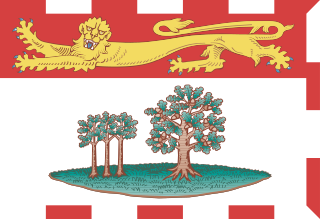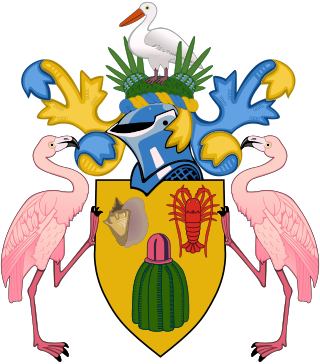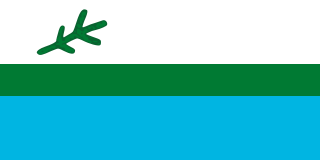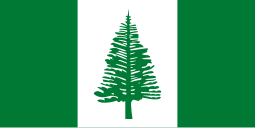
The Union Jack, or Union Flag, is the de facto national flag of the United Kingdom. The Union Flag was also used as the official flag of several British colonies and dominions before they adopted their own national flags. The flag continues to have official status in Canada, by parliamentary resolution, where it is known as the Royal Union Flag.

The flag of Newfoundland and Labrador was introduced in 1980 and was designed by Newfoundland artist Christopher Pratt. The flag design was approved by the House of Assembly of the province of Newfoundland, Canada, on May 28, 1980. It was flown for the first time on Discovery Day, June 24, 1980. The name of the province was changed to Newfoundland and Labrador by an amendment to the constitution of Canada in December 2001 at the request of the provincial legislature.

The national flag of Austria is a triband in the following order: red, white, and red.

The national flag of Norway is red with a navy blue Scandinavian cross bordered in white that extends to the edges of the flag; the vertical part of the cross is shifted to the hoist side in the style of the Dannebrog, the flag of Denmark.

In British maritime law and custom, an ensign is the identifying flag flown to designate a British ship, either military or civilian. Such flags display the United Kingdom Union Flag in the canton, with either a red, white or blue field, dependent on whether the vessel is civilian, naval, or in a special category. These are known as the red, white, and blue ensigns respectively.

The flag of Bulgaria is a tricolour consisting of three equal-sized horizontal bands of white, green, and red. The flag was first adopted after the 1877–1878 Russo-Turkish War, when Bulgaria gained de facto independence. The national flag at times was charged with the state emblem, especially during the communist era. The current flag was re-established with the 1991 Constitution of Bulgaria and was confirmed in a 1998 law.

The flag of Bolivia is the national flag of the Plurinational State of Bolivia. It was originally adopted in 1851. The state and war flag is a horizontal tricolor of red, yellow and green with the Bolivian coat of arms in the center. According to one source, the red stands for Bolivia's brave soldiers, while the green symbolizes fertility and yellow the nation's mineral deposits.

The flag of Prince Edward Island consists of a golden lion passant on a red field in the upper portion and a white field charged with three oak saplings and a large oak tree on a green island in the bottom portion. This is bordered on three edges other than the hoist by a fimbriation of alternating red and white rectangles. Adopted in 1964 in the run-up to the Canadian Centennial, it has been the flag of the province since March 24 of that year. It is a banner of arms modelled after the province's coat of arms. When flown with the flags of other Canadian provinces and the national flag, it is eighth in the order of precedence.

The flag of the Faroe Islands is an offset cross, representing Christianity. It is similar in design to other Nordic flags – a tradition set by the Dannebrog of Denmark, of which the Faroe Islands are an autonomous territory.

The flag of Saint Helena consists of a Blue Ensign defaced with the shield from the British overseas territory's coat of arms. Adopted in 1984 shortly after the island was granted a new coat of arms, it has been the flag since. Saint Helena's flag is similar to the flags of eight other British Overseas Territories, which are also Blue Ensigns with their respective coats of arms.

The flag of Saint Vincent and the Grenadines is a Canadian pale triband consisting of blue, gold, and green bands charged with three green diamonds at the middle. Adopted in 1985 to replace a similar design used from the time of independence, it has been the flag of Saint Vincent since that year. The design of the present flag entailed substituting the country's coat of arms on a breadfruit leaf with the diamonds. They are a reference to both the letter "V", which is the first letter of the country's name, and its nickname as the "Gems of the Antilles" and "Jewels of the Caribbean". Accordingly, the flag itself has been given the moniker of "The Gems".

The national flag of Ukraine consists of equally sized horizontal bands of blue and yellow.

The flag of Nova Scotia consists of a blue saltire on a white field defaced with the royal arms of Scotland. Adopted in 1929 after a royal warrant was issued, it has been the flag of the province since January 19 of that year. It is a banner of arms modelled after the province's coat of arms. Utilized as a pennant since 1858, it was officially recognized under primary legislation as Nova Scotia's flag in 2013. When flown with the flags of other Canadian provinces and the national flag, it is fourth in the order of precedence.
A triband is a vexillological style which consists of three stripes arranged to form a flag. These stripes may be two or three colours, and may be charged with an emblem in the middle stripe. All tricolour flags are tribands, but not all tribands are tricolour flags, which requires three unique colours.

The coat of arms of the Turks and Caicos Islands consists of a gold-coloured escutcheon (shield) charged with a conch shell, lobster and a cactus, supported by two flamingos, and topped with a pelican in the crest. Adopted three years after the islands became a Crown colony, it has been the coat of arms of the Turks and Caicos Islands since 1965. The escutcheon is featured on the flag of the territory. The previous badge featured two mounds of salt in front of a ship, with doors added to the mounds after they were reportedly mistaken for igloos.

The coat of arms of Jersey is the heraldic device consisting of a shield charged with three gold leopards on a red field. Utilised unofficially before the 20th century, its status as the coat of arms of the Bailiwick of Jersey was formalized in 1907. The escutcheon is featured on the flag of the dependency.

The states and territories are the second level of government of Australia. The states are administrative divisions that are self-governing polities that are partly sovereign, having ceded some sovereign rights to the federal government. They have their own constitutions, legislatures, executive governments, judiciaries and law enforcement agencies that administer and deliver public policies and programs. Territories can be autonomous and administer local policies and programs much like the states in practice, but are still legally subordinate to the federal government.

The flag of Labrador, while unofficial, is used to represent Labrador, the continental region with adjacent islands of the Canadian province of Newfoundland and Labrador as distinct from the Newfoundland region of the province. It was created by a small group led by Michael S. Martin, who was then the representative for Labrador South in the provincial legislature. The flag has been influential in Labrador; its colours are mirrored in the flag of Nunatsiavut, and its black (bog) spruce twig was adopted for use on the Franco-Terreneuvien flag. The black spruce, a member of the pine family, is the most numerous tree in Labrador and in the Province of Newfoundland and Labrador. The black spruce is the official tree of the Province of Newfoundland and Labrador and thus serves as a reminder that Labrador is part of that larger entity.

New England has no official flag. However, there have been many historical or modern banners used to represent the region in its history. While there are some variations, common designs include a plain colored field with a pine tree in the canton. The eastern white pine is the most common and prominent symbol of New England and is featured on many of the region's flags.

The national flag of Ireland, frequently referred to in Ireland as 'the tricolour' and elsewhere as the Irish tricolour is a vertical tricolour of green, white and orange. The proportions of the flag are 1:2.




















